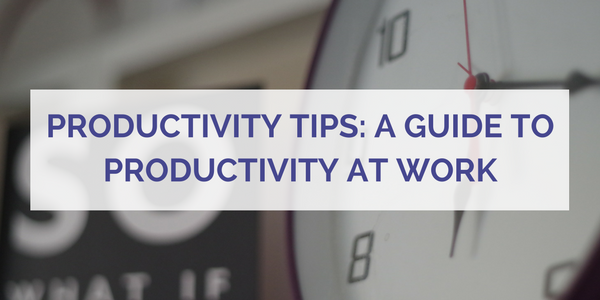
With workloads becoming more challenging and the working day growing increasingly longer, it’s vitally important to be more productive to help you keep a healthy work-life balance. Whether you work from home or from the office, there are always plenty of distractions which take your eye off the ball. Here’re five simple techniques to help you achieve more in your working day.
Optimise your time
I have two important questions for you.
1. Do you know how long all your daily tasks take?
2. Do you know which are your most important tasks that you should give more time to?
If you know the answers to these questions, then managing your day should be easy. If you don’t then you’ve got a problem, but here’s how to solve it.
Record how long each of your daily tasks takes you. You could do this the old-fashioned way or use a tool like Toggl (which is simple and easy to use). Find out how long your tasks are taking you and decide how important each task is to your daily goals. Then, assign yourself a time limit for each task, based on their importance. By doing this you can ensure you are not wasting too much time on tasks with low importance, which in turn, will help you create more time for those important tasks that require more time and energy.
Don’t let others ‘steal’ your time
Be strict with the time you’re willing to give up for meetings. Some meetings are important and vital to the successful execution of your projects or tasks, however, many companies suffer from meeting overload! You may get sucked into attending a meeting where you are a bystander for much of the agenda, or you may not be needed at all.
Before agreeing to attend every meeting you get invited to, ask yourself if it will help you achieve your objectives. If it doesn’t, see if there is another way you can contribute, perhaps by submitting information in advance or attending in a less time-consuming way, perhaps by phone or virtual meeting software.
Take regular breaks
None of us can focus with 100% concentration all day. In fact, attempting to do so is counterproductive. Take short breaks of around five minutes in between heavy going tasks to allow your brain to recover and refocus. Do something light, that you ‘want’ to do, to give your brain the reward it deserves. Regularly rewarding yourself in this way will help you focus more during ‘work’ time.
It’s also important to use break times to get away from your desk for a while. Get some exercise by taking a walk around the office, or even better, get outside for a short walk. This will not only help improve your health but help you to clear your head and refocus.
Don’t be distracted by notifications
One of the biggest causes of lost productivity is the technology designed to help us be more productive! Phones, tablets and computers, with their continuous alerts and notifications can be very distracting. Yes, they can be a help, when we are waiting for an important email or message, but notifications can cause us to quickly lose our focus, resulting in tasks taking much longer than they should. Turn your phone notifications off, shut down your email and devote your time to the completion of your tasks. When you’re finished, you can turn them back on again and address them when you have the time to do so.
Experiment with productivity techniques
There are many productivity techniques out there that can really help you improve your efficiency, and we’ve written about quite a few of them here on the Time for You blog. Research a few of them and start to experiment to find out which best suits your working style. Some are incredibly simple, while others are a little more complicated. You may find that you like elements of a few different techniques and create your own strategy.
For me, a combination of techniques helps me tackle different tasks and workloads. The Pomodoro technique helps me focus on big tasks that require a lot of brain power, whilst ‘to-do’ list techniques, such as the Eisenhower matrix, helps me to structure my working day or week more efficiently.
You can read more about some very effective productivity techniques in the following articles.
Written by Mike Pye